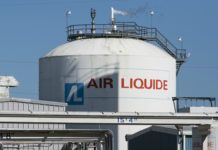It represents a monumental shift in mindset. Owners in the industrial space are no longer digging in their heels in resistance to a changing global energy dynamic.
Instead, they are preparing for the inevitable “energy transition.”
Along the way, they’re discovering real job-creating potential in a brave new environmentally conscious world. With that as part of their motivation, in 2021 the Water Institute of the Gulf in Baton Rouge and nonpartisan think tank Energy Innovation launched the Louisiana Energy Policy Simulator, or EPS, to model how particular climate policies would not only reduce greenhouse gas emissions but create jobs as well.
What they found was surprising.
“We looked at the jobs creation potential from the strategies and actions proposed by Louisiana’s Climate Initiative Task Force and found that by 2050 there would be more than 165,000 in net new jobs created through the plan,” says Allison DeJong, senior planner at the Water Institute and project lead.
The Louisiana EPS modeling tool allows users to evaluate specific climate policy proposals and assess the economic, jobs and public health impacts of those policies in an easy-to-use web interface. As a policy simulator, it’s very complex, “but it has a ‘business as usual’ set of variables and then a set of policies that you can turn on and off, set different schedules and intensities or manipulate through a web application,” DeJong says. “From that, you can get a number of different outputs.”
It predicts job creation in three market sectors: fossil fuels and utilities (including renewable forms of energy), manufacturing and construction, and others.
“The vast amount of investment in the task force plan comes from industrial electrification, renewable energy and switching to hydrogen … they’re all huge job creators due to the labor required to make that happen.”
Going forward, the Water Institute plans to fine tune the data by “refining our data set and continuing to make adjustments and improvements over time.”
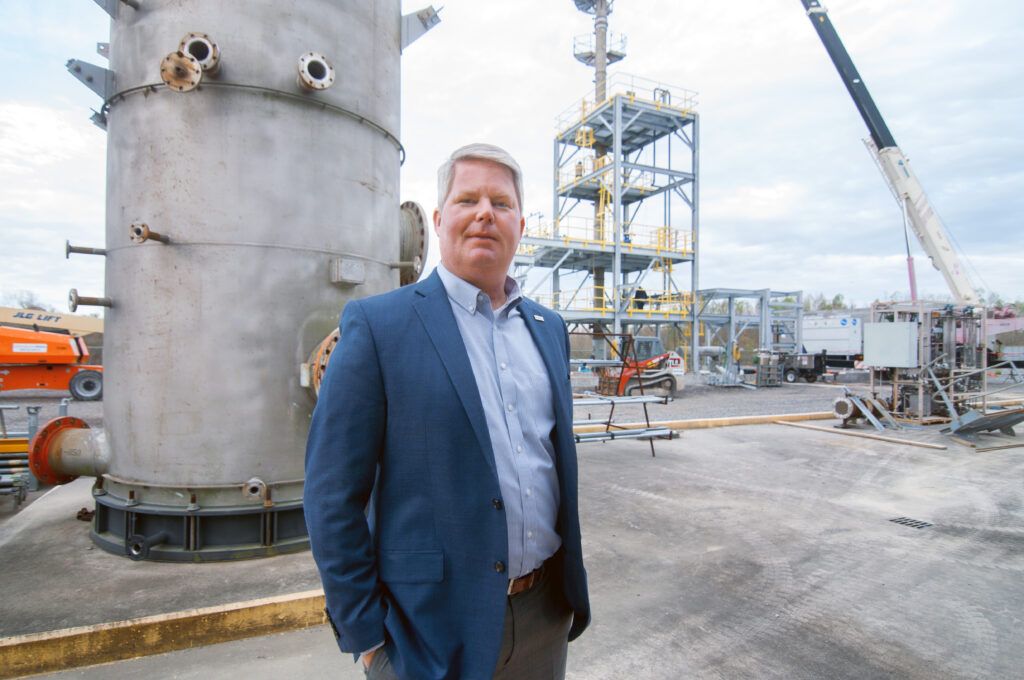
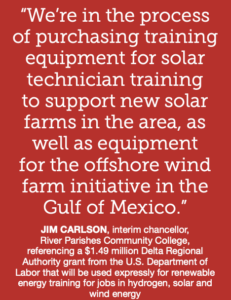 Academia is taking its own steps to proactively stay ahead of the jobs curve. Jim Carlson, interim chancellor at River Parishes Community College, says a $1.49 million Delta Regional Authority grant from the U.S. Department of Labor will be used expressly for renewable energy training.
Academia is taking its own steps to proactively stay ahead of the jobs curve. Jim Carlson, interim chancellor at River Parishes Community College, says a $1.49 million Delta Regional Authority grant from the U.S. Department of Labor will be used expressly for renewable energy training.
Co-sponsored by GNO Inc. and Associated Builders and Contractors’ Pelican and Bayou chapters, the DRA investment will assist RPCC in providing training opportunities for jobs in hydrogen, solar and wind energy. The money will also be used to support a new Process Equipment Trainer Plant at the school’s Gonzales campus, which will be operational this summer.
Ultimately, RPPC will have the ability to train students as wind and/or solar technicians, in addition to a variety of other opportunities in renewables.
“We’re in the process of purchasing training equipment for solar technician training to support new solar farms in the area, as well as equipment for the offshore wind farm initiative in the Gulf of Mexico,” Carlson says. Electrolysis training will also be included in the portfolio, in support of efforts by CF Industries and others to produce green ammonia.
Of course, private industry is taking the lead in turning many of these new initiatives—whether wind power, biofuels, carbon capture or solar—into real-world investments. Many have already made radical changes to their business models to prepare for these new environmentally focused opportunities, while remaining true to their traditional customers.
IT’S NOTHING NEW FOR KEYSTONE ENGINEERING
Mandeville’s Keystone Engineering Inc. began testing the waters in the renewable energy market over a decade ago. Sara Ghazizadeh, an LSU engineering graduate and current manager of renewable energies at Keystone, says the 30-year-old engineering company patented its first “twisted jacket” foundation for offshore wind in 2007. “We designed and installed our twisted jacket for a wind tower in the North Sea, and that opened up a whole new world to us,” Ghazizadeh says.
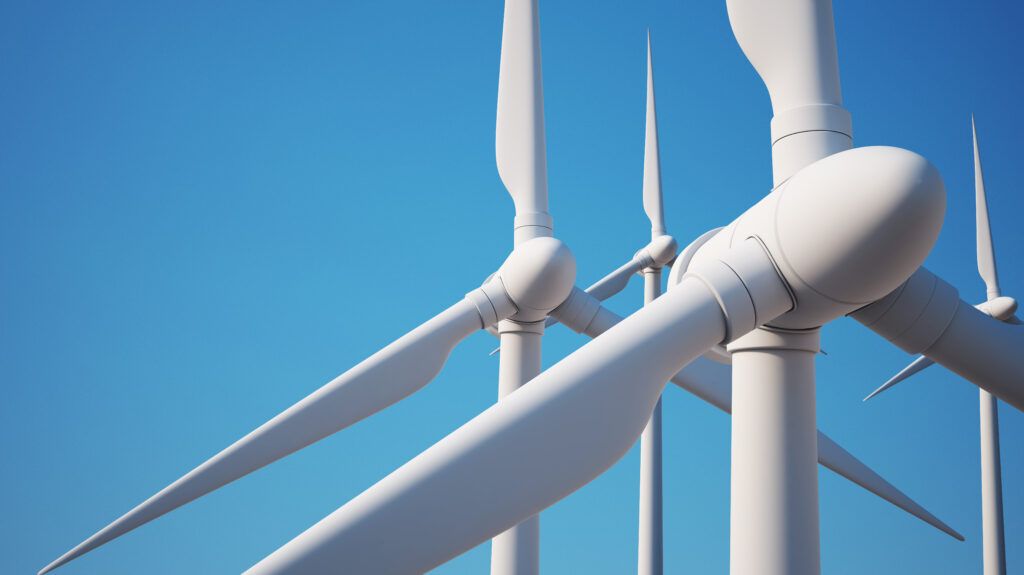
The firm’s most high-profile project came five years ago, when it designed five, four-pile jacket substructures for the Block Island Wind Farm off the coast of Rhode Island. It was the first offshore wind farm to be constructed in North America and demonstrated that offshore wind energy is economically feasible in the U.S.
During the project, Keystone provided on-site engineering, construction support, load-out analysis and sea fastening support for the structures, while leveraging technologies developed for the offshore oil and gas industry to meet the jacket foundation’s complex design criteria. Gulf Island Fabrication in Houma played an equally critical role by fabricating the jackets.
Ghazizadeh stresses that Keystone has never abandoned its traditional oil and gas roots in Louisiana, but like many companies has added renewables to its portfolio. It wasn’t as difficult a transition as one might think. “We have a lot of great engineers who have decades of experience in offshore oil and gas, and that’s directly relevant to the work we do for offshore wind,” she says.
“The big difference is the dynamic nature of the offshore wind turbine loading,” she adds. “That adds another level of complexity to the offshore platform design, but we still prefer to have engineers who have that offshore oil background.”
Keystone is proactively promoting offshore wind in the local market by working closely with GNO Inc. and participating in advocacy events such as Louisiana Wind Week 2021, organized by the governor’s office. Additionally, they’re in discussions with manufacturers and fabricators about turning Louisiana into a hub for offshore wind from a supply chain perspective and pursuing possible pilot projects to showcase the local capabilities of fabricators and designers.
“We want to educate the public about the benefits of the market, and we’re in talks with big offshore wind developers in the Gulf of Mexico that have showed interest,” she adds.
Ghazizadeh feels Louisiana is ideally positioned “for a real breakout” in offshore wind, but there are some roadblocks to clear first.
Many regions of the country have “local content requirements” that inhibit the participation of Louisiana companies. Additionally, the barrier to entry is high for fabricators.
“In general, this market is very competitive,” she adds, “and there needs to be some initial investment for fabricators to be able to fabricate jackets. That initial investment is quite large.”
From a strategic standpoint, Keystone plans to open an office on the East Coast in the near future. And recently, the engineer announced a new partnership with Natural Power, a leading renewable energy consultancy and service provider, for the purpose of pursuing and collaborating on technical consulting and advisory business opportunities in the U.S. offshore wind market.
The partnership will enable both parties to benefit from each other’s experience and expertise, and collectively ensures an even broader range of qualifications for project developers and investors.
“Keystone is the leader in offshore foundation design,” she says. “We are trying different avenues to make sure that the oil and gas industry, and the skillsets that we have as a region, can be transferred to offshore wind.”
ENLINK MIDSTREAM USES WHAT IT ALREADY HAS
Scott Goldberg is excited about his fledgling role as vice president of carbon solutions at EnLink Midstream in Dallas. He has only been in the position for about 10 months, “but that makes me a veteran, because everyone in this business in new,” Goldberg says. “Everything has accelerated over the last year and more companies are thinking about it and devoting resources to it.”
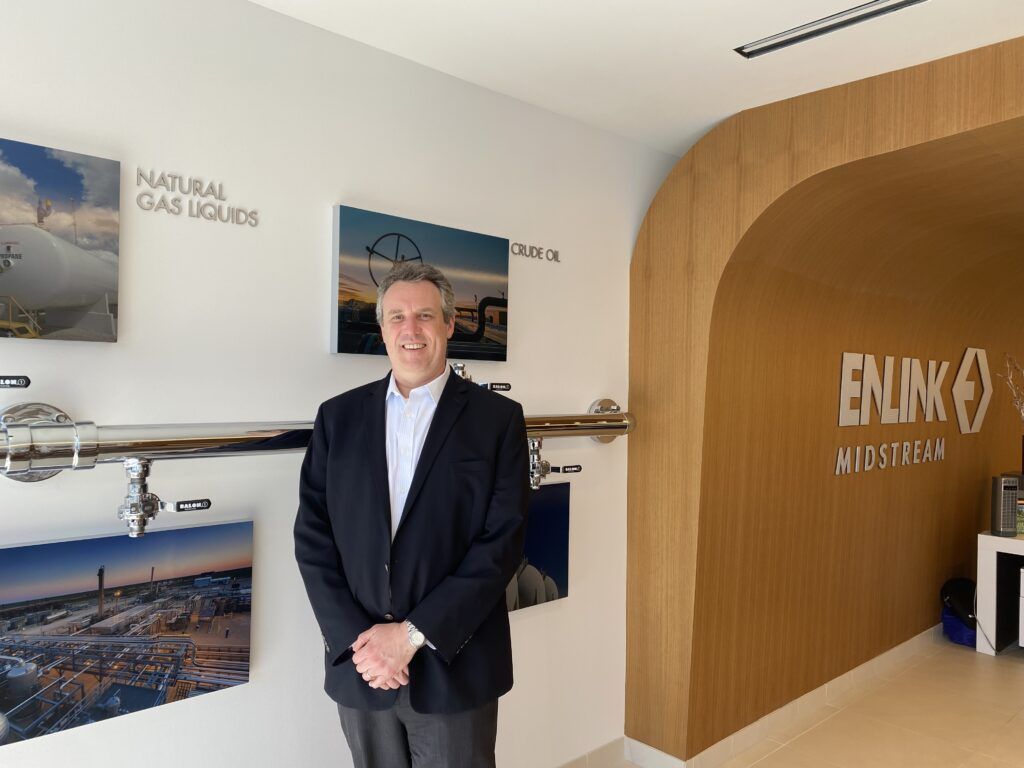
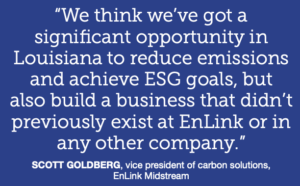
An 11-year employee at EnLink, Goldberg spearheaded the idea of targeting the carbon capture, utilization, and storage, or CCUS, market with the company’s existing network of pipelines. It’s rare for CCUS sites to be co-located, since certain geological conditions and land rights need to be present.
“So there is an opportunity for the transportation of CO2 by pipeline,” he says. “It might be a few miles, or it might be 50 miles, so that’s the range we’re pursuing.”
EnLink looked across its nationwide platform and quickly settled on Louisiana to launch the initiative, where it already has thousands of miles of pipeline connected to the largest sources of emissions along the Mississippi River. The company also has a strong local presence, with 230 employees in its Lafayette office and field offices across the region.
“We think we’ve got a significant opportunity in Louisiana to reduce emissions and achieve ESG (Environmental, Social and Governance) goals, but also build a business that didn’t previously exist at EnLink or in any other company.”
Many of EnLink’s pipeline are duplicative, Goldberg says, which means the company can use its existing network for carbon transport.
“There are segments that we can segregate from the natural gas system to convert into a CO2 system,” he adds. “The segments will then be isolated, evacuated, tested and then converted into CO2 service to deliver to the sequestration facilities.”
The actual conversion process is not terribly complicated, Goldberg says, and will be consistent with how EnLink already operates.
“It’s a different product that we’re transporting, but we’ll be transporting CO2 in a gaseous state, and in that way it’s a lot like natural gas. Additionally, the pressures in the line are similar.”
Nevertheless, EnLink doesn’t have extensive subsurface expertise, so in February it partnered with Talos Energy Inc. to offer a complete CCUS solution for industrial-scale emitters in the state. The service will be focused on the Mississippi River corridor from New Orleans to Baton Rouge and will use significant portions of EnLink’s existing regional pipeline infrastructure of about 4,000 miles.
For its part, Talos recently acquired the River Bend CCUS site in east Louisiana, with a sequestration capacity of over 500 million metric tons.
Of course, the industry as a whole is facing its own challenges. Most importantly, there have been no Class 6 permits issued by the EPA, to date, for CCUS wells in Louisiana.
While permit applications have been filed, “everyone remains in the developmental process,” Goldberg says. “Nevertheless, we have a deal with the landowner to do this service, so the next steps will include a significant geologic analysis and the preparation and submittal of the Class 6 permits.”
At the same time, EnLink will begin promoting the service to various upstream companies and planning for the conversion of its existing pipeline system.
“We will primarily use our existing pipelines, which makes our offering unique. That way, we can reduce the overall cost, which will result in lower fees for customers.” To date, EnLink has talked to 20 or so potential customers who are all interested in CCUS.
TURNER ENERGY PREPS FOR A CHANGE
Stephen Toups, president and CEO of Turner Industries, says irrespective of its new subsidiary, Turner Energy, his company has already completed an impressive portfolio of work in the renewables market over the last decade.
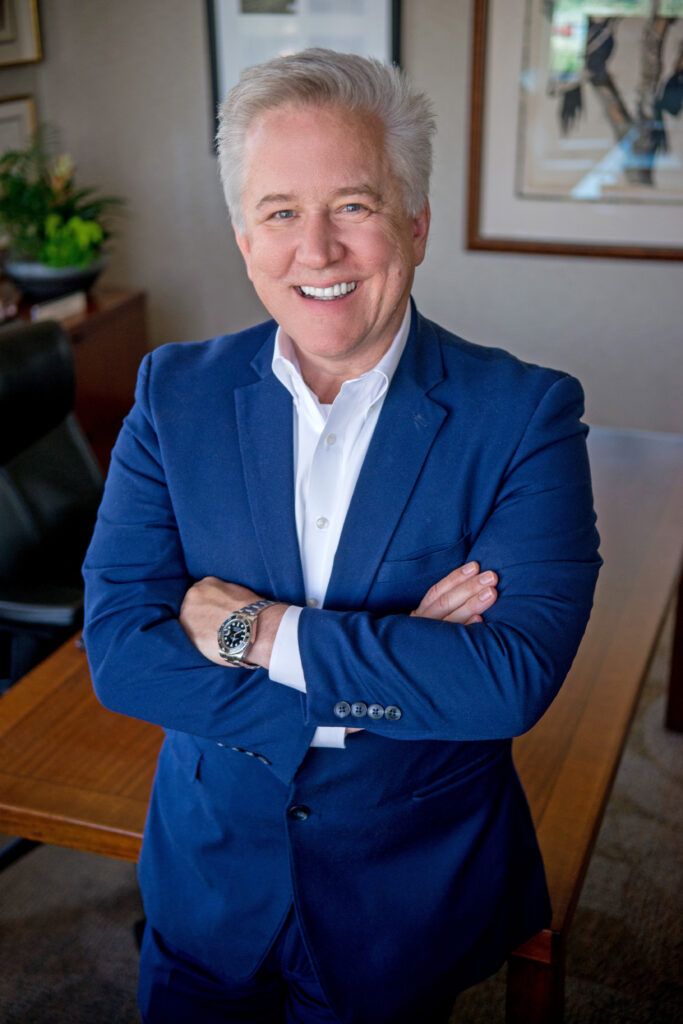
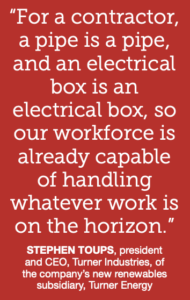 “While Turner Energy will re-introduce Turner Industries to the growing renewables market, we’ve always been an active player in that space,” Toups says.
“While Turner Energy will re-introduce Turner Industries to the growing renewables market, we’ve always been an active player in that space,” Toups says.
In the beginning at least, Turner Energy will utilize much of the corporation’s existing resources to pursue new business and lean upon its existing craft workforce. At the same time, it will give Turner the flexibility it needs to pursue projects that aren’t in its current wheelhouse.
“Turner Energy will allow our existing operations group to pursue work that might not exist within our current operations model,” Toups says.
Biodiesel and alternative forms of fuel will be of particular interest, as well as carbon capture solutions, LNG and hydrogen. A lot of the current projects on the horizon will likely come from existing clients who are simply pursuing new methods for producing energy.
“As projects come online, they’ll be funded from a variety of sources, and the contracts or terms might look different from transitional projects. Turner Energy will provide us with the flexibility that we need, no matter the sources of funding or contractual arrangement,” he adds.
Toups is excited about the potential of the new endeavor, adding that most of Turner’s skillsets are easily transferable to renewable work. “For a contractor, a pipe is a pipe, and an electrical box is an electrical box, so our workforce is already capable of handling whatever work is on the horizon,” he says.
Through Turner Energy, they’ll marshal the experience that they already have around such things as alternative energy, carbon capture, batteries, offshore windmills, solar etc. to ensure that their resources are easily accessible when the time comes.
“We truly don’t see a downside to this,” he adds. “It’s not a separate company; instead, it will enable us to focus our resources for anyone that’s interested in an alternative energy source.”
Going forward, Turner will likely hire additional personnel to back up the effort, but that hasn’t happened yet. “Right now, during COVID, there haven’t been a lot of projects going forward. There are a lot of people that we’re talking to about it, but as these projects begin to develop, we’ll possibly hire more people to work specifically on renewable energy projects.”
NOT SITTING ON THE SIDELINES
Perhaps nothing was more indicative of industry’s changing mindset than the slate of panelists at LMOGA/LOGA’s Annual Industry Conference in Lake Charles March 7-8. The conference kicked off with panels discussions with titles like “Industry & the Energy Transition” and “Carbon Capture.”
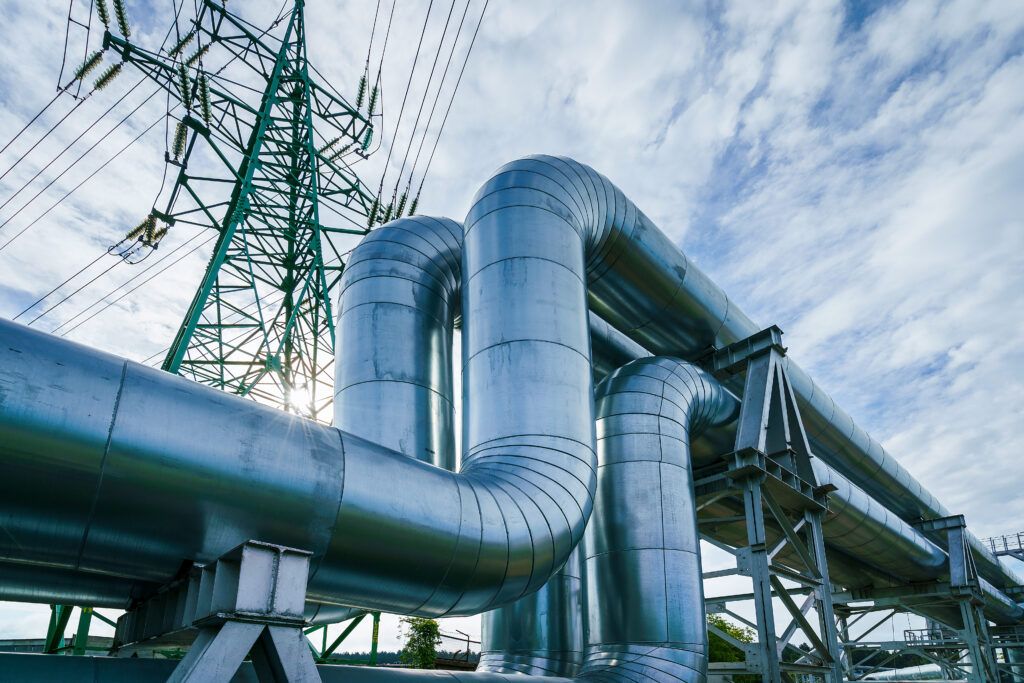
During the energy transition discussion, Simon Moore, vice president of investor relations for Air Products, told the gathering that providing clean energy is nothing new for his company.
“We’ve been in the hydrogen business for decades,” Moore says. “We’re the world’s largest operator of hydrogen assets; about 25 percent of our business today is producing hydrogen.”
That’s a big reason that Air Products is leading the energy transition effort with shovel-ready projects, he adds. Last year, Air Products announced a $4.5 billion blue hydrogen clean energy complex in Ascension Parish, representing the company’s largest-ever Investment in the U.S. at 750 million standard cubic feet per day in production.
“Blue” products are those produced utilizing hydrocarbons as a feedstock, with the carbon dioxide in the production process captured for permanent sequestration. A portion of the blue hydrogen will be compressed and supplied to customers by Air Products’ hydrogen pipeline network, which stretches more than 70 miles from Galveston Bay to New Orleans. It can supply customers with more than 1.6 billion cubic feet of hydrogen per day from approximately 25 production facilities.
Approximately 95 percent of the CO2 generated at the facility will be captured, compressed and transported safely by pipeline to multiple inland sequestration sites located along a pipeline corridor extending up to 35 miles to the east of the new production facility.
The megaproject is expected to be operational in 2026.
Air Products has some 700 miles of pipeline in Louisiana alone, serving the petrochemical and refining industries with hydrogen.
“We’re building on that hydrogen expertise and are recognizing the energy transition that the world is going through,” Moore says. “Everywhere in the world they’re looking for lower-carbon forms of energy, and hydrogen offers tremendous opportunities.”
Aaron Smith, business development manager with Colonial Pipeline, says his company’s efforts to tap into CCUS will intensify in 2022, and will depend heavily upon its existing network of Gulf Coast pipelines and customers in south Louisiana.
“It’s a real opportunity for us, so we’re looking at how can we support our customers with pipeline transport solutions,” Smith says. “There’s a great opportunity for carbon sequestration and movement of CO2 in this footprint.”
It’s still in the exploratory phase, but much of the initiative would be accomplished through the installation of new pipelines, Smith says. “We are looking at additional infrastructure investment for the most part, but we’ll also piggyback off of existing pipelines where that makes sense.”






